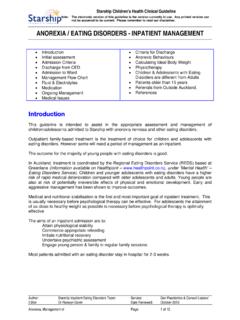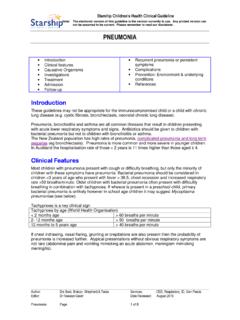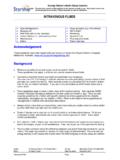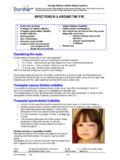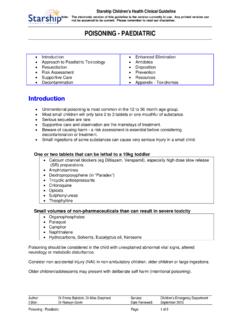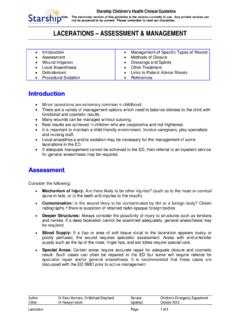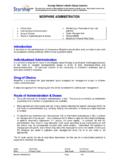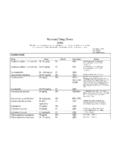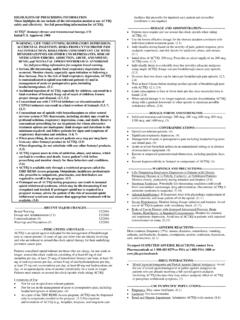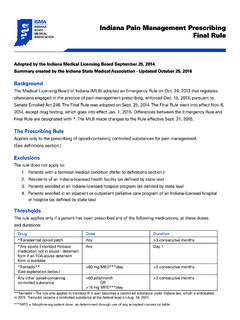Transcription of STARSHIP WITHDRAWAL OF ANALGESIA AND …
1 STARSHIP Children's Hospital STARSHIP WITHDRAWAL OF ANALGESIA AND SEDATION Patients receiving ANALGESIA and/or sedation for longer than 5-7 days may suffer WITHDRAWAL if these drugs are suddenly stopped. To prevent this happening drug doses are slowly reduced while observing the patient for signs of WITHDRAWAL and treating this appropriately. Optimise non-pharmacological measures to reduce WITHDRAWAL . This includes reducing environmental stimuli, ensuring adequate hydration, frequent feeds for infants, and optimising patient position. WEANING A decision is made to cease opioids and benzodiazepines when they are no longer required.
2 This may involve stopping them immediately or decreasing the dose over a number of days (weaning). If a patient has received ANALGESIA or sedation for: Less than 5 days - drugs may be stopped without gradual weaning. 5 to 10 days stop drugs and perform WAT-1 scoring. If weaning required, doses should be reduced by 20% every 24 hours and stopped after 6 days. >10 days - doses should be reduced by 10% every 24 hours and stopped after 10 days. NB: This is 10 or 20% of the ORIGINAL dose WITHDRAWAL is highly variable so these patients all need to be observed closely for signs of WITHDRAWAL during the weaning and cessation of sedatives and opiates.
3 We use the WAT-1 scoring tool ( WITHDRAWAL Assessment Tool 1). Scoring is performed 12 hourly near the start of each shift. If there has been evidence of WITHDRAWAL and intervention was required repeat WAT-1 scoring 1 hour post intervention. If a child is being enterally fed, change to equivalent doses of oral medications for weaning. See Appendix for dose equivalence. Reduce ANALGESIA and sedation together but if there are signs of WITHDRAWAL it may be beneficial to reduce one at a time. Agents should then generally be weaned in the following order: 1.
4 Morphine, fentanyl or methadone (unless on long-term opioid use) 2. Midazolam or diazepam 3. Chloral Hydrate 4. Clonidine Clonidine (oral or IV) 1-2mcg/kg tds may be added to facilitate weaning (if the patient is not already receiving it). This should allow more rapid weaning of both opiates and benzodiazepines. It may also prevent WITHDRAWAL symptoms in patients weaning from chloral hydrate and promethazine. Once the drug (s) has been ceased the patient needs to be observed for signs of WITHDRAWAL for the next 72 hours. Author: David Buckley Page 1 of Issued:June 2016 STARSHIP Children's Hospital MIDAZOLAM / DIAZEPAM The IV dose can be decreased as above if remaining on an infusion OR the patient converted to IV or oral diazepam and then weaned.
5 If converting to diazepam calculate equivalent 24hr dose as per Appendix and divide into Q4H dosing (Q6H if < 1yr). If on IV midazolam infusion halve infusion rate by 50% after 1st dose of diazepam given. Cease IV Midazolam with 2nd dose of diazepam. OPIOIDS The preferred agent is oral morphine. If appropriate a long acting morphine derivative may be used and dosed every 12 hours m-Eslon. NB: These capsules cannot be crushed so are only suitable for children who are old enough to swallow capsules. Calculate the total dose of opioid administered in the last 24 hours and convert to morphine equivalent.
6 Give oral morphine if the enteral route is available and divide 24hr dose into Q4H doses (Q6H if < 1 year). Treat breakthrough pain with other analgesics or bolus morphine. Decrease the dose according to the above guidelines. CHLORAL HYDRATE Patients who have been receiving regular chloral hydrate for more than 5-7 days may also experience WITHDRAWAL . If they show signs of WITHDRAWAL , start oral diazepam at then treat as per the benzodiazepine weaning instructions. Chart a small prn dose of chloral hydrate (10-20mg/kg) for the first few days while the diazepam dose is being optimized.
7 CLONIDINE If a patient has received clonidine for: Less than 7 days and the dose prescribed is less than 1mcg/kg/ dose every 6 hours (or ) - this may be stopped without gradual weaning. This equates to 4mcg/kg/24hrs. Less than 7 days and the dose prescribed is more than 1mcg/kg/ dose every 6 hours (or ) - the dose should be reduced by 50% every 24 hours for 3 days then stopped. 7 days or more - the dose should be reduced by 1mcg/kg/ dose (or ) every 24 hours until the dose reaches 1microg/kg/ dose . This dose should then be continued until other agents are stopped, then weaned by 50% every 24 hours for 3 days.
8 If the patient has been on a clonidine patch at a dose > 4mcg/kg/day they need weaning by switching to IV/PO preparation and weaning as above. During WITHDRAWAL of clonidine the patient should have their blood pressure monitored and documented every 6 hours (at the same time the sedation WITHDRAWAL score is documented). If the mean BP increases by more than 50% over 24 hours, contact the primary team registrar for review and slow down the weaning of clonidine. A patient must continue to have 6 hourly measurement of BP until 24 hours after the last dose of clonidine.
9 Author: David Buckley Page 2 of Issued:June 2016 STARSHIP Children's Hospital WEANING ADJUNCTS 1. Clonidine Clonidine is also a useful adjunct when weaning opioids or benzodiazepines. The usual dose is 1-2mcg/kg PO or IV Q4-6H. It can also be given as an infusion at doses up to 2mcg/kg/hr or as a transdermal preparation which comes as 100, 200, or 300mcg/24 hour patches which last for 1 week. Choose a patch size that delivers around 6-10mcg/kg/24hrs. Do not exceed 12mcg/kg/24hrs. Elimination of clonidine is decreased in patients with renal impairment.
10 2. Dexmedetomidine ( PICU only) A selective alpha-2 agonist like clonidine but has much greater receptor affinity. Not affected by renal impairment as almost all is metabolised in the liver. Expensive and usually used for <48 hours. Produces a state of sedation and ANALGESIA without depressing respiration and patients can be weaned from benzodiazepines and opioids while on a dexmedetomidine infusion. Given by infusion usual dosing is load IV over 15 minutes then infuse at titrating to effect. After prolonged use (>24 hours) stopping the infusion abruptly can cause WITHDRAWAL .
